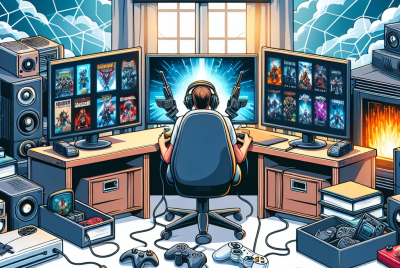Implementing Augmented Reality in Games
Implementing Augmented Reality in Games”
In our ever-evolving digital landscape, augmented reality (AR) has become a groundbreaking addition to the gaming industry. As we explore this dynamic technology, we’ll dive into the steps and tools required to seamlessly blend virtual elements into our physical environment. By incorporating AR, we can elevate gameplay experiences to new heights, creating immersive worlds that captivate and engage players like never before. Let’s embark on this exciting journey and uncover how to bring the magic of augmented reality into our games. How do you implement augmented reality in games? This is a question that brings together technology enthusiasts, game developers, and curious minds alike. As we delve into the fascinating world of augmented reality (AR), we aim to provide a comprehensive guide on implementing AR in gaming. From the basics to advanced techniques, we’ll cover everything you need to know to create an immersive gaming experience.
Understanding Augmented Reality
Augmented Reality, or AR, is a technology that superimposes computer-generated images, sounds, and other sensations onto a user’s view of the real world. This technology can transform the way we play games by blending digital objects with our physical environment.
The Evolution of AR
AR has come a long way since its inception. Initially, it was used in industrial and academic fields, but it has since evolved into something much more accessible and fun, largely due to the advent of smartphones and AR glasses. We now see AR being utilized in various applications, from education to retail, and most notably, in gaming.
Why Choose AR for Games?
Why should we consider AR for our game projects? The answer lies in its unique ability to create immersive experiences. Traditional games are confined within a screen, but AR games break through that barrier, blending real-world environments with digital enhancements. This creates a more engaging and interactive experience for players.
Prerequisites for Implementing AR in Games
Before we dive into the implementation process, it’s important to be aware of the prerequisites necessary for AR game development.
Hardware Requirements
To develop and play AR games, certain hardware requirements must be met. Here’s a simple table summarizing the key hardware components needed:
| Hardware | Description |
|---|---|
| Smartphones/Tablets | Devices equipped with a camera and AR-compatible processors (e.g., Apple A12 Bionic, Snapdragon 845). |
| AR Glasses/Headsets | Optional but beneficial for fully immersive AR experiences (e.g., Microsoft HoloLens, ARKit Glasses). |
| PC/Laptop | Used for developing AR content with appropriate specs for running AR development tools. |
Software Requirements
We also need specific software to develop AR games. Let’s break down the essential software:
| Software | Description |
|---|---|
| Game Engine | Unity or Unreal Engine are popular choices due to their AR support and robust features. |
| AR SDKs | ARKit for iOS, ARCore for Android, and Vuforia are widely-used software development kits for AR capabilities. |
| Development Tools | Visual Studio, Xcode, or Android Studio for coding and debugging. |
| 3D Modeling Software | Tools like Blender, Maya, or 3ds Max for creating 3D assets. |

Steps to Implement AR in Games
With prerequisites in place, let’s move on to the step-by-step process of implementing AR in games.
Step 1: Define Your Concept
We need a solid game concept that leverages AR features. This means brainstorming ideas that integrate real-world interaction with digital elements. Whether it’s a treasure hunt in your neighborhood or a virtual pet living in your living room, the concept should capitalize on AR’s strengths.
Step 2: Choose the Right AR SDK
Choosing the appropriate AR SDK is crucial. ARKit is ideal for iOS, while ARCore suits Android development. If we aim for cross-platform support, Vuforia can be a great choice. Evaluate features like object tracking, performance, and ease of use when selecting your SDK.
Step 3: Setting Up the Development Environment
Setting up the development environment involves installing the game engine and AR SDK, and ensuring they work harmoniously. Here’s a quick setup guide:
- Install Unity/Unreal Engine: Download and install your preferred game engine.
- Install AR SDK: Add the AR SDK to your game engine. For Unity, this may involve downloading AR Foundation and relevant packages.
- Setup IDE: Ensure your integrated development environment (IDE) is configured to work with your game engine and AR SDK.
Step 4: Creating and Integrating 3D Models
Creating 3D models is an integral part of AR game development. We can create these models using software like Blender or Maya, then import them into our game engine. Properly optimizing these models is critical to ensure smooth performance on target devices.
Step 5: Developing Core Mechanics
Core mechanics in AR games involve interaction between the game and the real world. This can include:
- Object Detection and Tracking: Ensuring digital objects correctly overlay and interact with real-world surfaces.
- User Interactions: Allowing players to manipulate digital objects using gestures and movements.
- Spatial Mapping: Creating a map of the physical environment for the game to understand and interact with.
Step 6: Testing and Optimization
Testing an AR game is different from traditional game testing because of its dependency on real-world scenarios. We must test in various environments and lighting conditions to ensure consistent performance. Optimization involves fine-tuning 3D models, code, and AR features to enhance performance and battery life.
Step 7: Deployment
Once testing is complete, the next step is deploying our game to app stores. This involves adhering to platform-specific guidelines (Google Play for Android and App Store for iOS). Ensure our game meets all AR-specific submission criteria.
Advanced AR Techniques in Gaming
As we get more comfortable with basic AR implementation, we might want to explore some advanced techniques to enhance our games further.
Multiplayer AR Gaming
Creating a multiplayer AR experience can significantly elevate player engagement. This involves synchronizing AR content across multiple devices, allowing players to interact with the same digital elements in a shared physical space.
Persistent AR
Persistent AR allows digital objects to remain in the same location between gaming sessions. This can be achieved through cloud anchors or spatial anchors, creating a consistent AR experience over time.
Machine Learning in AR
Incorporating machine learning can make AR games more intuitive. For instance, using machine learning models to recognize objects or environments can trigger specific game elements, making the game world feel more responsive and intelligent.
Real-time Data Integration
Using real-time data, such as weather information or location-based services, can make AR games more dynamic and contextually relevant. Imagine a game that adapts to the current weather, adding rain or sunshine effects to the digital environment.
Common Challenges and Solutions
Let’s address some common challenges faced during AR game development and their solutions.
Challenge: Performance Issues
AR games can be resource-intensive, leading to performance bottlenecks.
Solution: Optimize 3D models, textures, and code. Use level of detail (LOD) techniques and occlusion culling to manage rendering efficiently. Profile performance regularly and adjust as needed.
Challenge: Inconsistent Real-World Tracking
Tracking issues can ruin the AR experience, causing digital objects to drift or misalign.
Solution: Calibrate sensors and use advanced tracking algorithms. Ensuring the AR SDK is up-to-date can also mitigate tracking problems.
Challenge: Player Safety
Players often get immersed in the AR experience and may overlook their real-world surroundings, leading to potential safety hazards.
Solution: Implement safety warnings and guidelines within the game. Encourage players to use their device’s AR safety features, like boundaries and alerts for obstacles.
Challenge: Device Compatibility
Ensuring our game works across a range of devices with varying capabilities can be challenging.
Solution: Develop a minimum device specification and perform extensive compatibility testing. Provide scalable graphics settings to accommodate lower-end devices.
Future Trends in AR Gaming
As technology continues to evolve, so too will the landscape of AR gaming. Here are some trends we might expect to see in the near future.
Augmented Reality Glasses
As AR glasses become more advanced and affordable, they will likely replace smartphones as the preferred AR gaming platform, offering a more immersive experience.
Enhanced AI Integration
AI will play a bigger role in creating more responsive and intelligent AR environments. We might see non-player characters (NPCs) that react more naturally to real-world changes and player actions.
Mixed Reality (MR)
Mixed Reality, which blends AR and Virtual Reality (VR), will create even richer gaming experiences. Imagine a game that can switch between immersive VR worlds and interactive AR environments seamlessly.
Haptic Feedback
Adding haptic feedback to AR games will enhance the tactile experience, allowing players to feel virtual objects and interactions through touch.
Conclusion
Implementing augmented reality in games opens up a myriad of possibilities to create unique and engaging experiences. By understanding the basics, setting up the right tools, and tackling common challenges head-on, we can successfully bring our AR game ideas to life.
As we continue to explore and innovate within this space, the future of AR gaming looks incredibly promising. We hope this guide provides a solid foundation for your AR game development journey. Let’s embark on this exciting adventure together, pushing the boundaries of gaming and technology!




